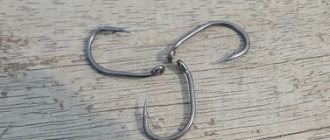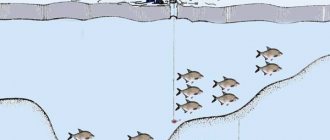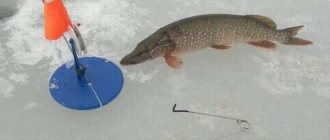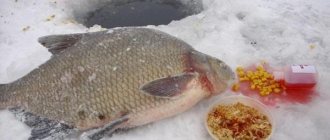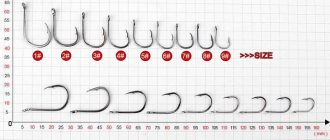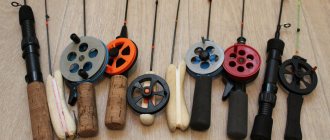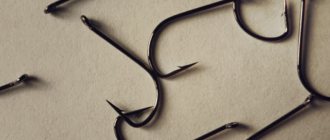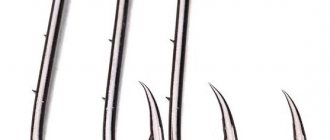When going bream fishing, you should not only stock up on a good fishing rod, but also purchase good bream hooks that will meet all the requirements. First of all, you need to select a part for the nozzle. The material must be durable and of high quality. Particular attention must be paid to sharpness, because a dull element will lead to the fact that the fisherman may be left without a catch.
The size of the hook cannot be ignored. Experienced people are advised to look carefully when choosing the color of the element, which is selected based on the bait used. Some anglers believe that the type of water body and weather do not affect the part, but this is not true. Similar points should also be taken into account. When purchasing, you should also look at the manufacturer.
Important! When going fishing, you need to take with you not just one hook for bream, but several, which will differ from each other.
This will be discussed in more detail later.
Hook shape
There are a great variety of hooks on sale today, but not every one is suitable for fishing bream. The element must be such that it is possible to capture and also carry out a sweep. If this does not happen, then you cannot expect a good result.
The forms are:
- Classic - with a round bend. Despite the fact that there seems to be one hook, there are differences in it, which lie in the sting. It can “look” outward, to the side, or even inward. You should pay attention to the classic option if you are fishing for bream using vegetable bait, which does not hold well on the hook, but it is necessary to make a long cast. In this case, you can use any tackle.
- Flat or flattened. A similar hook for bream, with grooves and an extended shank, should be used if dough, corn, bloodworms and the like are used as bait. Most often, bream fishing is done on a feeder.
- Breams. Such elements do not have any special features. Despite this, they are recommended to buy them for beginners who do not know where to choose. This species can be used with almost all baits and tackles.
What are hooks made of?
Hooks for catching bream are made of special heavy-duty wire. It is worth noting that they differ in steel - there is high-carbon steel, which is considered practical and reliable, and there is regular steel. True, in order for the products to last as long as possible, they must be coated with an anti-corrosion layer. Stainless steel is considered the most expensive type of steel, but at the same time this metal is one of the most durable, although, of course, it has a great many positive qualities.
Important! If you want the hooks to last as long as possible, it is best to purchase expensive stainless steel elements.
Criteria for choosing a bream hook
When choosing hooks for bream, factors such as shape, size, thickness, color and the metal from which they are made are taken into account.
Hook shapes
The shape of the hook - the outline of its hook, the sting, the length of the fore-end. The following common forms of this fishing accessory are used in bream fishing:
- "Aberdeen" - products with a classic round hook shape, with a long fore-end and a simple sting. They are used when catching bream using various feeder rigs and a summer float rod.
- “Limerick” - have a semicircular shape with a beveled occipital part and a sting bent to the side. They are used not only in summer (feeder, float rod), but also in winter gear.
- “Crystal” is a variation of the previous type, characterized by a sting located in the same plane as the fore-end. These hooks are used mainly in ice fishing.
To catch bream, you need hooks that have a quick hooking response. Therefore, short and hooky carp hooks of the “Beaked carp” type are not used. Possessing high strength and thickness of the wire, they can tear the fish’s lip when hooked. In addition, such carp accessories are quite expensive. Also, fishing hooks that have an angular shape are not used in bream rigs.
Which size to choose
The choice of a particular hook size (number) for bream also depends on the type of gear used:
- For river and lake feeder gear, products No. 10-12 are used. At the same time, the larger ones are used for fishing with worms, the smaller ones - with maggots and bloodworms.
- For a summer float fishing rod, products No. 8-10 (for worms and plant baits), No. 12-14 (for bloodworms, maggots) are more suitable;
- For winter gear (float rod, winter feeder), small items No. 14-16 are used.
We recommend reading: Winter fishing for bream on a float
In addition to the type of gear, the choice of hook size is also determined by the planned weight of the fish being caught. So, when catching small bream and bream weighing up to 1.5 kg, use products No. 12-14. For larger fish, use hooks No. 10-12.
Thickness and color of hooks
The choice of one or another color of hook for catching bream depends on the bait used:
- Bronze (“Brown”) – suitable for catching bream in the summer using vegetable baits such as corn, mastyrka, and dough. Thanks to their color, they camouflage the bait well against the background of a sandy bottom.
- Red (“Red”) – used both in winter and in the warm season for fishing with bloodworms and maggots.
- Black (“Black”) – having a black galvanic coating, they are used for summer fishing with a worm, shell, and horse leech.
- Green (“Forest Green”) - used for summer fishing for bream with bloodworms and maggots in reservoirs with a dark muddy bottom.
- Accessories with a silver coating (White and Oxidize White) are used less frequently. Products coated with purple and blue colors are not used in freshwater bodies due to their contrast.
The thickness of the wire from which these bream accessories are made depends on the fishing season and gear:
- For summer gear, hooks made of wire 0.5-0.7 mm thick are used;
- For ice fishing, products made from thinner wire with a cross section of 0.3-0.4 mm are used.
This difference in wire thickness is explained by the less intense resistance of the fish during fishing in winter.
In addition to the thickness of the wire and color, when choosing this fishing accessory, you must also take into account the sharpness of its sting. To check this characteristic, the sting is pressed against the nail and pulled forcefully along its surface. The blunt tip will advance easily without leaving a visible scratch. An accessory with a sharp sting will move from its place with noticeable force. Sharpening a dull or dull tip, if necessary, is done using a small diamond file.
Material of manufacture
Modern hooks for catching bream are made from the following materials:
- Carbon steel is a highly durable material. Accessories made from it are used for catching trophy bream weighing more than 1.5 kg. The disadvantage of products made from it is the rather high price.
- High carbon steel is a material that has medium strength and flexibility. Products made from it are used for amateur bream fishing. A significant disadvantage of this material is its high susceptibility to corrosion. Therefore, accessories made from it in most cases have a special anti-corrosion coating.
We recommend reading: The best wobblers for pike perch
Those models that are produced without coating require additional processing - nickel plating, galvanizing or simple coating with waterproof varnish.
Stainless steel products are practically not used for bream. They are used mainly for sea fishing: catching bream on them is unprofitable and impractical.
Hook sharpness: what does it affect?
A hook is an element that not only must exist, but must be sharp and durable. The possibility of hooking directly depends on this. Even if the product is a little dull, this can affect the fact that the fish at the most inopportune moment will jump off and swim away, breaking the fishing line. Experienced fishermen note that even under ideal fishing conditions, it will not be possible to catch something worthy if the hook does not meet all the stated requirements. You should check the tip not from time to time, as some do, but constantly, especially if fishing takes place on a rocky bottom, on which the hook can hit during a fall.
You can check the tip in several ways:
- It is necessary to inspect the product. If rust is noticed or the element looks somehow wrong, it means it will not “work”.
- Hold the hook and run it along the nail. With a blunt hook, the product will slide well, and with a sharpened one, it will cling to the nail plate.
- You need to press the tip a little on the beam. A sharp product will lead to an injection and unpleasant sensations.
When choosing a hook, you also need to pay attention to the dimensions of the future catch - this is almost one of the most important criteria.
Characteristics Analysis
In addition to the number, thickness and shape, there are additional factors to consider. For attachment to the fishing line, the design may include a closed ring or blade. The first is convenient for knitting catch, but affects the increase in size. When choosing small sizes, it is recommended to choose a shape with a spatula - after tying a knot, the wire will visually immediately move to the fishing line, without intermediate elements in the form of a ring.
How to tie a shock leader to a spinning line - carrot and albright knots

When choosing, pay attention to the following qualities:
- Color. Depends on the type of bait. Bread or dough requires a white surface; worms, maggots and caterpillars are placed on burgundy, blue or green hooks. Red ones are for bloodworms, yellow ones are for corn.
- Coating. Varnished ones are the most unstable, they can be fished up to 10 times, then the coating wears off. It is better to use hooks with a nickel surface.
- Sharpness. After several bites, the sting may become dull - this needs to be checked before each catch. Fishing with fishing gear that is not sharp enough will not bring the expected results.
Some manufacturers offer exclusive hooks for this type of fish, supposedly different from the standard ones in shape. In practice, small changes in configuration will not affect the likelihood of a successful catch, and in some cases may negatively affect the bite. It is recommended to choose classic and time-tested models.
The video material reveals the secrets of choosing fishing equipment as fully as possible:
How to choose hooks for bream
Experienced people say that regardless of the size, you can go home with a full bucket (or even more than one) of fish. At the same time, in order to achieve what you want, you should adhere to some important rules.
They are as follows:
- If you choose red or yellow bait, then it is best to choose hooks in sizes 6 to 10.
- The hook number for baits such as bread, porridge, corn and similar ones should be selected in the range of 8-14.
- If you use several maggots at the same time, then numbers from 10 to 14 are used.
- When fishing with bloodworms, these numbers are 14-16.
- If the angler is going to fish with foam, it is recommended to pay attention to hooks No. 18.
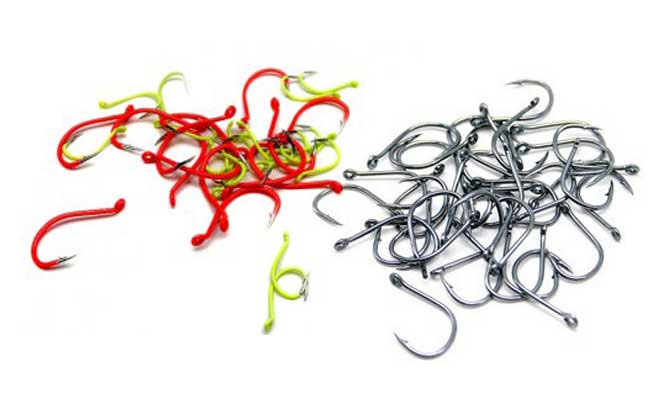
Many anglers who have been fishing for bream for years, or even decades, are convinced that fishing with small hooks often gives better results than with large ones. The reason is that it is much easier to hide the sting with bait on a small product than on a larger one. In addition, it increases the likelihood that the fish will notice the treat and not the hook. The bream will also be able to completely swallow a small bait along with the hook, resulting in a hook.
At the same time, there are fishermen who note that a small hook for catching bream also has its disadvantages, among which the fish jumps off the hook.
If we talk about the advantages of large elements, then these also exist. If you want the bream to bite, then there is no point in using small elements. In addition, it will be more difficult for the trophy to fall off a large hook. The negative aspects, as already noted, include the visibility of the element. And, as you know, bream is not just careful, but extremely careful.
Read the article with the most popular hook knots.
Hook size
Stores sell them in various sizes, designated by numbers corresponding to the length of the forend.
In general, small ones, No. 14-10, are suitable for catching medium, small bream, larger items, No. 8-4, are necessary for hunting large individuals. It is reasonable to stick to the golden mean in selection, focusing on the expected catch. It is quite possible to catch quite large bream on hooks No. 10-8.
The peculiarity of the inhabitants is that the bait is practically not savored. Small ones can jump out only by damaging the mucous membrane. A large element of tackle will catch faster, secure itself more securely, and will not allow the trophy to fall off after a bite.
Experienced fishermen always keep stings of various sizes in stock for replacement in order to make fishing more successful
Element thickness and color
In the summer, thickness is of enormous importance, because a thin product will not allow you to injure the bait and arouse suspicion in the fish. At the same time, in the warm season, hooking is more effective specifically for small items, because the fish are active during this period and swim up to the delicacies offered to them much more willingly.
If we talk about color, then it is worth saying that it plays an important role, so the element must be chosen carefully.
Namely:
- So, the white element is chosen if you are fishing with dough or bread.
- You need to take a closer look at blue, green, burgundy and other dark colors if maggots and worms are used.
- Red is chosen when catching bream using bloodworms.
- Golden or yellow are preferred when fishing for corn.
Important! It is better not to install varnished products because they are short-lived.
Manufacturers
Of course, the size of the hook for bream is of great importance, but no less attention should be paid to the producers. Today there are many companies on the market that offer products. However, there are no domestic companies that are worth paying attention to.
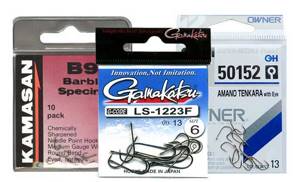
The ones that have proven themselves best are:
- Kamasan. The presented manufacturer is a leader and offers products made of light stainless steel. The installation is carried out very well, and the fishing is excellent.
- Gamakatsu LS-1010B is a model that allows you to fish with any bait and has a special coating.
- Gamakatsu LS-1040R. The presented product is suitable for feeder fishing and can be used with bait in the form of worms.
- Owner. This company has proven itself to be the best over the years. She offers the Owner 50152 model, which can be used with any bait, but is more suitable for feeder fishing. If an angler is planning to fish with a float, then he should pay attention to Owner 50152 - this element is best used with vegetable baits.
Despite the fact that the hook seems like an insignificant detail, you shouldn’t skimp on it, because without it the fishing rod will turn into a useless stick.
